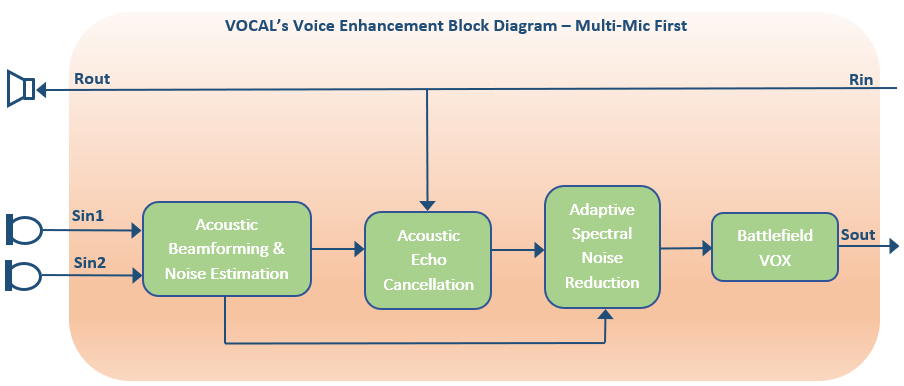VOCAL Technologies, Ltd. offers a Voice Enhancement software solution that significantly improves the speech quality of a radio communication device deployed in adverse noise conditions. How does one improve the voice quality? There are four main components to hands-free voice enhancement: multi-mic signal processing, acoustic echo cancellation (AEC), adaptive spectral noise reduction and battlefield voice activated transmission (VOX). The image below shows a block diagram on how these modules can be organized.
The inclusion of two (or more) microphones provides additional information about the acoustic environment. For radio applications, to help minimize power consumption, two microphone solutions are preferred over large microphone arrays. Dual-mic signal processing includes acoustic beamforming, which applies a spatial filter in the direction of the desired speech source. Dual-mic Noise Estimation is also performed and is used during the single channel noise reduction phase. Acoustic Echo Cancellation is a required component of a hands-free audio design due of the acoustic coupling between the radio loudspeaker and microphone(s).
After the AEC, Spectral Noise Reduction adaptively estimates the noise spectrum and attenuates the signal to emphasis speech. The final module is VOCAL’s Battlefield VOX software. The VOX is designed to only trigger on voice signals, thanks to preceding voice enhancement modules and the detection criteria of the VOX.
The Dual Mic Voice Enhancement software package makes for a good solution for any low power voice communications and voice control application. VOCAL has developed an evaluation version of this software utilizing a Raspberry Pi and the Respeaker 2 Mic Pi HAT. Please contact us to learn more about this solution.
